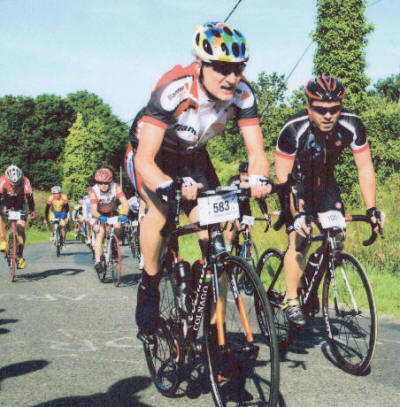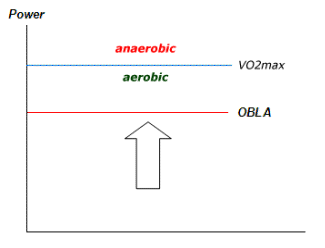VO2max ~ A Definition

Maximising our potential as racing cyclist's is within us all if we can just master some basic training concepts and conditioning principles.
One of the key aspects of physiology we need to get our head around to help us on our journey to success, is the aerobic engine. Because, no matter what anyone tells you, cycling is primarily an aerobic sport.
Realising our full potential may well be dependent on understanding how our aerobic engine limits us and what we can do to quantify, address and re-asses those limitations.
To get a better understanding of the relationships that determine the capacity and ultimate effectiveness of your aerobic engine, read the Lactate factsheet in conjunction with this one.
VO2max
When we cycle at "smelling the flowers pace," we breath air at a rate that supplies adequate oxygen to our
body that allows us to continue cycling without too much distress. At
this point we are cycling aerobically, or with oxygen. We can tell
we are cycling aerobically because there is enough left over to enable us
to talk!
However as effort increases, say we hit a hill and the pace rises to match the testosterone and ego levels of the group we are with. We eventually reach a point were we physically cannot breath in enough air to service the ever increasing requirements our effort demands.
We reach a point were we cannot provide enough speed enabling oxygen to our muscles and we drop back. This is our aerobic ceiling or VO2max.
We can tell when we're approaching this point as the talking stops! We can also tell those with a big engine, they're the ones riding away from us, or the ones still talking when we're breathing through our exhaust port.
The level at which we cannot increase our intake of oxygen, even though the exercise intensity is increasing, is our VO2max. VO2max is the maximum volume of oxygen we can consume.Once we go over this "line" we go anaerobic (without oxygen) and all sorts of weird things start happening. This mythical point of transition is demonstrated by the blue line in the graphic below.
The "line" isn't as clear cut as it seems. It's not a line as such, it's a zone in to which we stray. Your not aerobic at 99% and anaerobic at 101% There's loads of other stuff going on as well, but that's not for discussion today...

As you can see, the higher your VO2max, the faster you can go, or the more watts you can produce, without entering the anaerobic danger zone.
VO2max is measured in ml/kg/min; millilitres per kilogram a minute. It's simple technical description is:
"the maximum amount of oxygen you can take in and make use of "
The operative words here are, "make use of".
OBLA?
At some point before we hit our VO2max we come across the
mis-quoted and mis-described, "lactate threshold" (red line). Again, it's not a threshold!
It's the Onset of Blood Lactate Accumulation. Another zone we
will enter that is
effectively the boundary point stopping us from making use of our full
VO2max availability.
The further the red line is from the blue one, the further we are from realising our potential. The closer the red line is to the blue the more oxygen we can "make use of" and as you can see, the faster we can go.
Your VO2max can easily be quantified with a wVO2max Test. This test will quantify the maximum (max) volume (V) of Oxygen (O2) measured in millilitres, you can "consume" within a minute (min).
Measurement is expressed relative to an individuals bodyweight (kg) to make comparisons more representative. This is referred to as Relative VO2max. Absolute VO2max is the total oxygen consumed within a minute and is expressed as ml/min.
A 90 kilo rider could have a greater absolute oxygen consumption, say, 4.5 l/min, compared to a 60 kilo rider with 3.5 l/min.
However their relative measurements would be 50ml/kg/min and 58ml/kg/min respectively. Which paints a completely different picture! And that's before we take into account their OBLA figure (lactate threshold).
Scores on the Doors How big is big? The average sedentary male and female will be around the following VO2max's:
|
male |
42 ml/kg/min | |||
|
female |
38 ml/kg/min |
Elite cyclists have a VO2max of:
|
male |
75 ml/kg/min | |||
|
female |
56 ml/kg/min |
While others have been found to have:
|
Miguel Indurain |
90 ml/kg/min | |||
|
Chris Boardman |
80 ml/kg/min | |||
|
Locally Tested Cyclist |
64 ml/kg/min | |||
|
Shergar (the horse!) |
180/ml/kg/min | |||
|
Siberian Husky |
240/ml/kg/min |
VO2max is believed to reach maximal development at around 25 years of age and drops by 1% per year thereafter. Although the correct training regime can slow the decline. The graphic below shows the relationship between the air that we breath, the organs within our body and how the energy producing parts of our body use the oxygen as fuel.

The
Message
Although the size of your VO2max doesn't readily respond to training, the
percentage of it you can use is easily targeted. What's more your VO2max
can easily be quantified with a
VO2max Test. Knowing your VO2max is extremely useful but only if you do something with
the information you have.
Devising a training plan with the specific requirements of increasing your lactate threshold is a fantastic investment in your training time. But only if you know where your threshold is to begin with; otherwise how will you know how hard to go and how will you know if you've improved it?
Through increasing your cycling economy, lactate tolerance and power output you can make significant improvements in the efficiency of your aerobic engine thus allowing you to cruise at a faster speed.
We haven't raised the ceiling but we've expanded the percentage of the level we can use before lactate pooling begins.
And that, at the end of the day, is what wins races.








